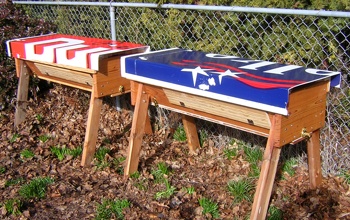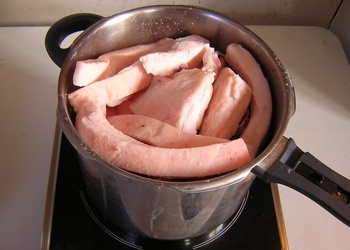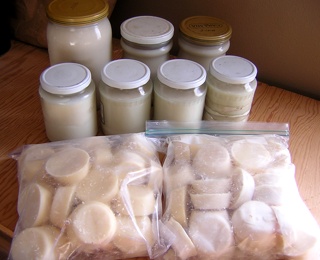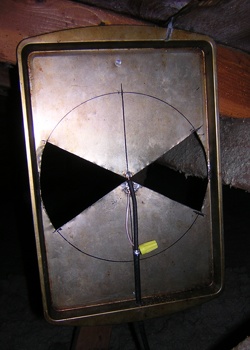
"So Merlyn sent you to me," said the badger, "to finish your education. Well, I can only teach you two things -- to dig, and love your home. These are the true end of philosophy."
- T.H. White, The Sword in the Stone
 Beekeeping -- 26 February 2013 -- I've been working on this project for months, and just added a new project page to the side bar on the left about building two top bar hives.
Beekeeping -- 26 February 2013 -- I've been working on this project for months, and just added a new project page to the side bar on the left about building two top bar hives. This photo shows only a fraction of the job -- I did five or six pots that size. The procedure is simple: put the fat in a pot at a low temperature for hours. You're doing two things: extracting the oil from the solid stuff in the fatty tissue, and driving off all the water. The second thing is exactly like making clarified butter. At the beginning of each batch I used the lowest setting on my induction burner to avoid burning the stuff on the bottom. Gradually the level of liquid rose, and I could get away with raising the heat a little to drive off the water. At this point the pot would be about half full of dark yellow bubbling liquid and shrunken partially cooked fat scraps. I kept it mostly uncovered, but I would partially cover it to see how much water was left by how much the bottom of the lid was steaming up. At some point I turned the burner back down to the lowest setting, and the fat scraps gradually got fully cooked. I knew they were done when I could squeeze them against the side of the pot with a wooden spoon and they would go almost flat.
This photo shows only a fraction of the job -- I did five or six pots that size. The procedure is simple: put the fat in a pot at a low temperature for hours. You're doing two things: extracting the oil from the solid stuff in the fatty tissue, and driving off all the water. The second thing is exactly like making clarified butter. At the beginning of each batch I used the lowest setting on my induction burner to avoid burning the stuff on the bottom. Gradually the level of liquid rose, and I could get away with raising the heat a little to drive off the water. At this point the pot would be about half full of dark yellow bubbling liquid and shrunken partially cooked fat scraps. I kept it mostly uncovered, but I would partially cover it to see how much water was left by how much the bottom of the lid was steaming up. At some point I turned the burner back down to the lowest setting, and the fat scraps gradually got fully cooked. I knew they were done when I could squeeze them against the side of the pot with a wooden spoon and they would go almost flat. This is a whole pig worth of lard. The hard stuff is in front, made into "lard pucks" with a cupcake pan. First I poured water in the pan to see exactly how much was a quarter of a cup. Then I poured lard in to that level, let it cool, froze it, banged it out on the counter, and put it in the bags. This is five pans, or sixty pucks. A quarter cup of lard is almost exactly 50 grams, and two pucks make a nice pie crust. Now I can use these directly for pies without having to measure. I also tried putting the soft lard in the cupcake pan, but even at freezer temperature it's too soft to cleanly come out of the pan, and too soft to store without a mess. So all the soft stuff is in the jars. That big jar is a half gallon, and the total volume is almost three gallons, or around 11 liters.
This is a whole pig worth of lard. The hard stuff is in front, made into "lard pucks" with a cupcake pan. First I poured water in the pan to see exactly how much was a quarter of a cup. Then I poured lard in to that level, let it cool, froze it, banged it out on the counter, and put it in the bags. This is five pans, or sixty pucks. A quarter cup of lard is almost exactly 50 grams, and two pucks make a nice pie crust. Now I can use these directly for pies without having to measure. I also tried putting the soft lard in the cupcake pan, but even at freezer temperature it's too soft to cleanly come out of the pan, and too soft to store without a mess. So all the soft stuff is in the jars. That big jar is a half gallon, and the total volume is almost three gallons, or around 11 liters. TV Antenna -- 14 January 2013 -- Back in October I bought an HDTV, and over the weekend I made this antenna and mounted it in the attic. My design is based on this video, The best DIY Antenna for HDTV, which I picked over many other designs because it looked easy and I already had all the parts... almost. I had coaxial cable, soldering equipment, and tinsnips to cut the pattern, but I didn't have a round biscuit tin, so I substituted a small cookie sheet that I got for a dollar from the dollar store. The video also says to make a little bracket for the cable, which I skipped.
TV Antenna -- 14 January 2013 -- Back in October I bought an HDTV, and over the weekend I made this antenna and mounted it in the attic. My design is based on this video, The best DIY Antenna for HDTV, which I picked over many other designs because it looked easy and I already had all the parts... almost. I had coaxial cable, soldering equipment, and tinsnips to cut the pattern, but I didn't have a round biscuit tin, so I substituted a small cookie sheet that I got for a dollar from the dollar store. The video also says to make a little bracket for the cable, which I skipped.Archives:
September - October 2004
November - December 2004
January - March 2005
March - April 2005
May - July 2005
August 2005
September - October 2005
January - April 2006
May - June 2006
August 2006
September - November 2006
April - May 2007
June - September 2007
April - June 2008
July - November 2008
January - April 2009
May - June 2009
July - August 2009
September - November 2009
January - April 2010
May - July 2010
August - October 2010
October - November 2010
May - June 2011
August - December 2011
April - September 2012